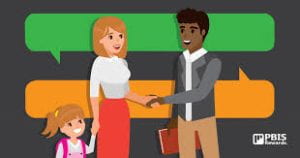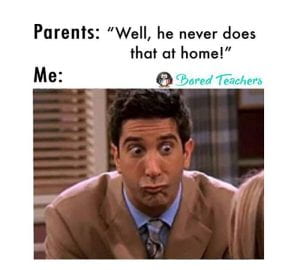Apr
2024
Home / School Connection
Beyond the Classroom Walls: Building Stronger Home-School Relationships
 https://www.pbisrewards.com/blog/improving-parent-teacher-communication/%5B/caption%5D
https://www.pbisrewards.com/blog/improving-parent-teacher-communication/%5B/caption%5D
Part 1:
Home/school connections are beyond an occasional parent-teacher meeting or report card sent home in the student’s backpack. Having and maintaining a good home/school connection between the families and teachers promotes a healthier learning and growth environment. Some ways in which this can be done are having effective communication and involving the families in school activities. By embracing a culture of inclusivity, transparency, and mutual respect, teachers and families can create a supportive environment for the students.
Borovoy (2016) describes many ideas for teachers and parents to connect and engage throughout the school year. This article shows multiple important factors along the lines of how parents can get involved, how to effectively communicate, and strategies, and tips for teachers with communicating with families.
Aguilar (2011) gives twenty tips for developing positive relationships with parents. It’s important to have good facial expressions, know their names, communicate often, ask questions, and listen! This will maintain a positive and healthy relationship between the teachers and families. By doing so, the students will have a better learning experience and feel more supported by their family and their teachers. This article would be beneficial for teachers to read over to be more confident in themselves before communicating to their student’s families.
Lastly, Breiseth (2021) is an important read since it includes ELL families. Communicating with ELL families can be a struggle but this article gives 10 strategies on how to make it easier for both the teacher and families. Communicating can be extremely challenging and has many responsibilities that come with it so learning how the families prefer to communicate and actively engaging in resources can make the entire process a lot easier. Breiseth (2021) stated that school districts are legally required to provide information in families’ home languages and that translators have multiple options. This is beneficial to know since these rules and regulations can ease any stress and anxiety about communicating with the families and faculty members.
One film we watched was The 5-Minute Film Festival: Parent-Teacher Partnerships showed a video of 300 parents receiving diplomas and being alongside teachers in the classrooms as parent mentors. The idea of parents assisting in the classrooms could be beneficial to have an extra set of eyes in the classroom, build relationships with everyone in the school, and help the teachers in the classrooms. I believe there could be some downside to this idea if a child becomes too attached to their parent or another child gets discouraged if their parent isn’t able to come into the class. It has many positive and negative aspects behind it but it could be a great idea to at least try!
Another film we watched was 9 Ways to Communicate with Parents for Teachers/Increase Parent Communication! This video gave many tips and strategies for communicating with parents in a timely matter. As stated earlier, improving your relationships with students’ parents can lead to students being more successful in the classroom! It’s important to acknowledge that not every strategy will work for every teacher or parent so it’s important to not be discouraged by it and change things up until you find what works best for both the parents and teachers!
For this week’s blog, we had the opportunity to attend a Board of Education Meeting. I attended the Bellmore-Merrick School District Board of Education Meeting on March 6, 2024. Going into it, I honestly thought it was going to be very boring but I was actually very engaged and interested the entire time. I even told my mom about it and said I wanted to go to another one! Throughout the meeting, the dean acknowledged every school in the district and many of their accomplishments from the last meeting to this one including the increase in the number of clubs, and how well all of the sports teams were doing. There was even a presentation from a group of faculty members describing their new club that had just begun where students can meet once a month and talk with other students, do activities, and meet new people. I found this to be a great program for students who may be shy or have a hard time making friends. Another event that happened during this meeting was all the families that came to support the holiday of Eid. They stated they have been coming for years and fighting for more days off for the students to celebrate their culture and holiday with their families without missing days of school. I found this very interesting since they listed many points as to why they have been and still are coming and fighting for this and curious as to why it hasn’t happened yet. I realized having that many days off may throw off the school calendar greatly and would need to redo it to make these families happy. Overall, it was a very interesting meeting and I would want to attend more in the future!
Part 2:
Communicating effectively with families is crucial for any teacher no matter what grade level and throughout the entire school year. There are many ways I intend to communicate with the families of my future students. I hope to become a kindergarten special education teacher so I feel like a welcome letter before the first day of school would be the first priority. This is a huge milestone for children and their families so introducing myself, sharing my background, and expressing my enthusiasm for working with the students is not only beneficial but could ease any anxiety for the families.
Throughout the school year, I would also plan parent-teacher conferences to discuss the child’s progress, strengths, and areas for improvement. In addition, I would set up a folder and include all of these aspects on written paper for the child to take home to their family. This makes it easier for the parent to be up to date with their child’s achievements or any challenges they may be facing. This is also extremely important, especially for special ed students, since it can all be documented and shared between the parents and teachers daily.
I would also be mindful of diverse communication needs within families, such as language barriers or disabilities, and ensure that any information is communicated in a way that is accessible to all parents. This could involve translators, visual aids, or alternate formats for communication. Breiseth (2021) is an important article to re-read since it includes ELL families and strategies for effective communication between teachers and families with a language barrier!
Lastly, I believe in “Open Door Policies” and will encourage the families to reach out with any questions, concerns, or ideas they may have about their child’s education. This can build trust and collaboration between the parents and teachers as well as give the child the best and most supportive education they can possibly get!
 https://twitter.com/artteacherjoys/status/1184712453738729472%5B/caption%5D
https://twitter.com/artteacherjoys/status/1184712453738729472%5B/caption%5D
References:
Aguilar, E. (2011, September 23). 20 Tips for Developing Positive Relationships with Parents. Edutopia. https://www.edutopia.org/blog/20-tips-developing-positive-relationships-parents-elena-aguilarLinks to an external site.
Borovoy, A.E. (2012, November 2). 5-Minute Film Festival: Parent-Teacher Partnerships. Edutopia. https://www.edutopia.org/blog/film-festival-parent-teacher-partnerships
Breiseth, L. (2021, August). Communicating with ELL Families: 10 Strategies for Schools. National Education Association. https://www.nea.org/professional-excellence/student-engagement/tools-tips/communicating-ell-families-10-strategiesLinks to an external site.
Family Engagement: Resource Roundup (2010, July 14). Edutopia. https://www.edutopia.org/home-school-connections-resourcesLinks to an external site.
Vestal’s 21st Centory Classroom (2021, August 22). 9 Ways to Communicate with Parents for Teachers // INCREASE Parent Communication!
. YouTube. https://youtu.be/8aHJkRXgbcE
davidsawicki
April 21, 2024 at 4:20 am (4 weeks ago)Hello Kaylee,
First I would like to say that your meme included in the post is very funny and relatable and fits with the theme of the current blog week! I agree that open door policies are very beneficial to encouraging students and families that may have concerns or questions and builds trust to both the teacher and family. Your idea about including a welcoming letter is also so unique and thoughtful for the student and family to read as it can help these students get out of their shell a little bit before entering their first day of school! A question I could ask is how else could parents take a role in the child’s education to make the connections with yourself and them stronger? I feel that having different ideas could help make something less hard for the students, this could also help you have more ideas if a current one fails or does not give you a significant outcome. One thing you could may add to make this post even better is maybe also focusing on boundaries for when parents could get too involved in the classroom as too much could also be negative. Overall, your post is very thorough on the points you were trying to make, your explanation on you board of education meeting was very informative, and I could see parents have a better understanding on who you are and more at ease if they read this post.
mrohr
April 23, 2024 at 6:42 pm (4 weeks ago)Hi Kaylee! Your post is really well organized. I also found it very interesting having parents work alongside teachers. Not only is it another set of eyes, but also may provide insight from parents on how to manage difficult situations with students. Your enthusiasm towards the faculty meeting was also really nice to read about as well. I love your idea of a welcome letter to your incoming students. It makes an immediate impression on both the parents and the students and gives students an idea of what to expect when coming into the classroom. I also really like the idea of giving parents a folder to take home with them. I agree it would help with keeping parents up to date, but also to help them understand exactly what their child needs help with and provides a way to track their progress. Your final point of the “Open Door Policy” is another thing I agree with and also would like to implement into my own classroom. Like you had stated, it helps parents to reach out with questions or concerns. Overall your blog post is well done! I loved all of the ideas you have for your future classroom. They have helped me to consider a few things for my own classroom as well.
gabbyl918
April 24, 2024 at 1:44 pm (4 weeks ago)Hi Kaylee I enjoyed reading your blog post this week! I like how you pointed out the importance of reaching out and connecting with families of ELL students. Even if the teachers themselves do not speak the language that the family does, that does not mean they should isolate and not speak to that family. Instead, it should be the opposite where teachers and families of the ELL students are in constant communication, ensuring that the student is doing well in classes, and providing resources in their native language to ease any anxieties they may have. After reading your plans for communicating with your student’s families, I wondered if you would be willing to implement any technology into your plans. Although in-person meetings are a great way to connect with parents, many of them will most likely have full-time jobs making this difficult to do with such limited availability. Implementing a technological aspect such as Remind or a Google Site may improve your communication instead of relying on in-person meetings only. I would love to see you expand on this idea some more in another post, as I think it would greatly elevate your already great plans.